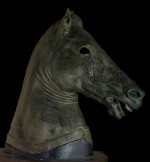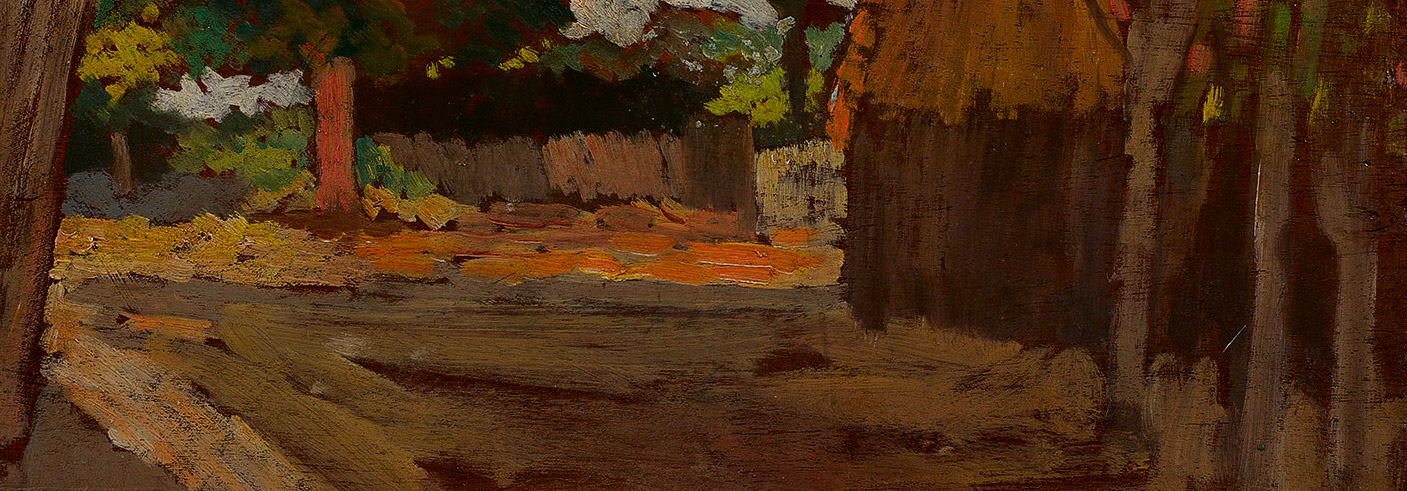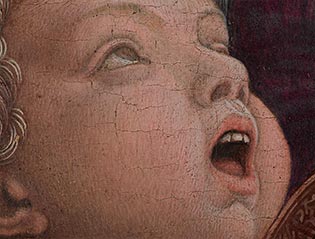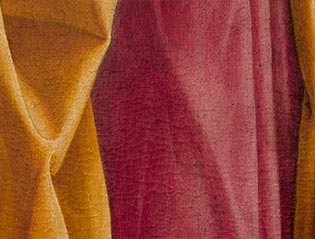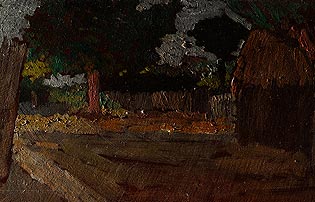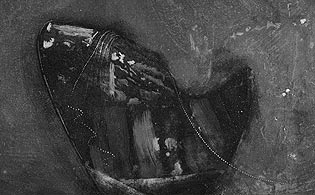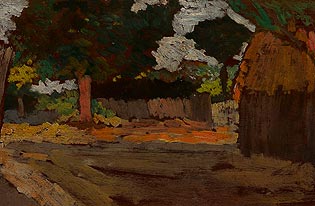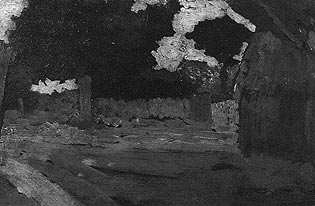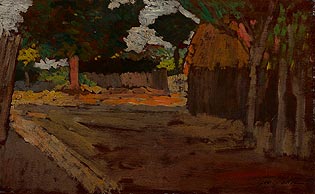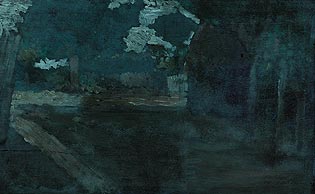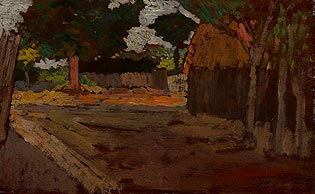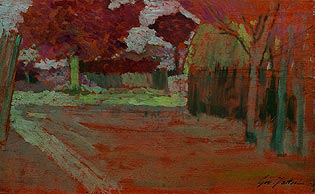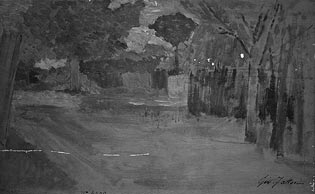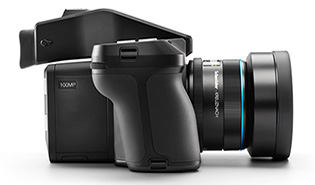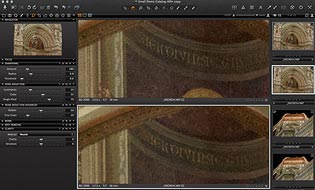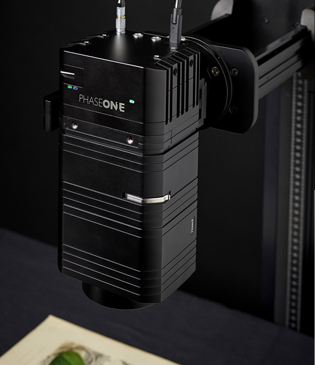Services
I offer a range of complete service packages: I fine-tune my services in the areas of documentation and art diagnosis according to your individual needs and your budget. My varied portfolio also makes my services an interesting option for smaller museums and collections.
Documentation
Images in high definition and with maximum
precision in the area of colour calibration

I give each individual object receives maximum attention and document it faithfully, using an optimised workflow or, on request, by staging it in the best possible light. Whether for your private archive or for the collection catalogue: the documented works enable an impressive “immersion” into details – both on a large screen and on your tablet PC. Naturally, you can also get all this as a bound catalogue.
An example: in May 2014, I photographed the bronze sculpture “Testa di Cavallo” at the Museo Archeologico Nazionale in Florence in a range of lighting options. Please do not hesitate to contact me – I will make you a suitable offer for your needs and your budget.
Documentation &
art diagnosis
Complete record and diagnosis of a work of art

From left to right: UV reflection, UV false colour image, UV fluorescence, visible light, infrared, infrared false colour image
-

multispectral imaging 360nm to 1000nm -

Detail from image above
Within the framework of the documentation, each individual object receives maximum attention and is documented faithfully by me using an optimised workflow or, on request, by staging it in the best possible light. The documented works enable an impressive “immersion” into details.
This kind of art diagnosis offers valuable information about the techniques used to create a work of art and the condition it is in.
Multispectral imaging is a non-invasive optoelectronic procedure. Further advantages: it is mobile, affordable and the first step towards a thorough art diagnosis. Recording the various layers provides immediate information about the surface, changes that were made after the work of art was completed, the signature and the choice of pigments. It is also ideally suited for supervising and documenting restoration processes.
An example: in September 2013, over the course of three weeks, I documented and diagnosed the art collection at the museum Casa Martelli in Florence comprising 150 paintings. Please do not hesitate to contact me – I will make you a suitable offer for your needs and your budget.
Additional service report
Evaluation of the data after completely recording and diagnosing a work of art
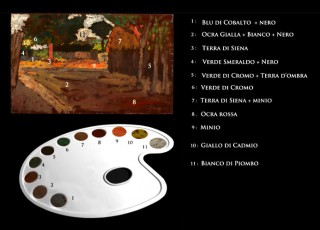
Prerequisite for the report is the service of documentation & art diagnosis. I am able to offer you the know-how of a competent team to evaluate the art diagnosis of your object. My experience shows that a network of art historians, technicians and craftspeople generates synergies when analysing the results of an art diagnosis. My partners are highly qualified restorers and art historians with many years of experience who have specialised in the field of art diagnosis. You will receive the report as a digital presentation or, on request, as a bound catalogue.
In 2016-2018 in a team with Prof. Roland Lenz, State Academy of Fine Arts in Stuttgart, I worked out reports for the study of wallpaintings for St. Stephen's Cathedral in Vienna and the monastery St. Johann in Müstair.
Consultation & training
Bespoke solutions and support during the realisation
I will advise you and your team before recording your collections and also offer bespoke training sessions. I will offer support with the organisation, realisation and specifications of the setup. Advantage: I would be happy to help you choose a suitable method. This way, you are sure to save time and money while choosing the module best suited to your needs. My services are calculated according to the actual efforts involved making the entire process effective and affordable.
I run one- and multi-day workshops on multispectral imaging and on professional image editing / calibration. An example: In 2017 and 2018 I prepared and held several 3- to 5-day trainings on the topic of multispectral imaging at the National Police and also to some Regional Police departments in Germany. The participants received an in-depth insight into the theory and practice, techniques and projects.
Please do not hesitate to contact me – I will make you a suitable offer.
Methods
15 years of professional practice in the area of multispectral imaging provide an expert foundation for scientific work
1. Exposures in visible range with diffused light
In a documentation, the objectively correct rendering of the work of art plays the most important role. This is the only way surface and colour changes can be compared and correctly interpreted later on. To this end, I use so-called diffused light. In lighting terms, this is a “soft” light, which illuminates the scene evenly and with little contrast. This in turn emphasises the significance of the image colours, which are essential for the pictorial design.
By using top-quality lenses and a professional colour calibration, I can guarantee an objective result. Close-ups and macro photography provide information even on minute details.
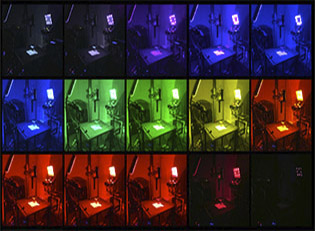
2. Narrow Band imaging
I am proud to have been part of the development team of the Phase One Rainbow MSI system, which is in function since 2020. It allows multispectral examinations, e.g. of art peaces and evidence in forensics, as well as the quality control of production processes to be detected non-destructively. Image sequences from UV to infrared, so-called stacks, are generated in the highest resolution (150MP) at the push of a button, perfectly calibrated and reproducible. There are 16 wavelengths available as illumination sources in the narrow band, each spectra detected separately. The images are calibrated using a PTFE target and converted into grayscale images. The analysis tool already integrated in the software enables the immediate statistical evaluation of the images beyond the visual approach and can thus make a significant contribution to legibility, for example "the separation" of inks, as well as represent material-specific differentiations. PCA (principal component analysis), ICA (independent component analysis) and K-Means cluster analysis are currently available in the software.
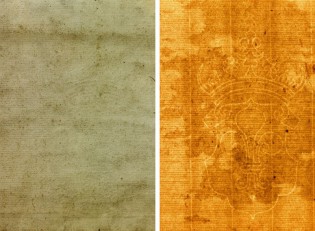
3. Transillumination
When employing this technique, I illuminate the work of art exclusively from behind. Depending on the thickness and the density of the undercoat and the colouring agent, varying degrees of translucency appear, by which the manner of painting can be further characterised. In addition, this method enables a documentation of the condition of the base material. This method is especially suitable for works of art on paper. It is also a quick and easy way of making watermarks visible and comparing them. This may give some indication of the place and time the work of art was created.
To download additional information, please click here:
auszug_transillu.pdf
4. Raking light
With this method, I visualise the surface structure, the technique and the conservation condition of the work of art. The information I glean here depends on the angle of incidence and the direction of lighting.
When the light hits the surface of the piece of art at an angle or almost parallel, it emphasises surface structures such as pastose paint applications, signs of damage on the surface and deformations of the base material. Information about the height of the protruding matter can be made with the help of a reference wedge and the length of the shadows.
5. Ultraviolet reflection
For a UV exposure, I use a light with maximum emission at 360 nm. By using a band-pass filter, I limit the exposure to approx. 340-375 nm. Special equipment is necessary to reduce the absorption of the UV light by glass. This technique is especially effective for characterising white and yellow pigments. Making the surface area visible like this helps with detecting residual matter of various origins and plays an important role in documenting restoration processes of paintings and cleaning processes of antique textile works of art.
6. Ultraviolet false colours
I co-developed this method in 2004 at the Opificio delle Pietre Dure in Florence. It changes the colours of an object drastically and is therefore called UV false colour image. The image is created digitally by changing the colour channels of the UV exposure and the exposure taken in diffused light. The professional calibration of all exposures plays an essential role here. This technique is especially effective for characterising white and yellow pigments. We can distinguish between modern and antique white pigments.
To download additional information, please click here:
auszug_transillu.pdf
OPD_restauro_2004_UVfalsecolour.pdf
OPD_restauro_2005_falsecolour.pdf
7. Ultraviolet fluorescence
Fluorescence is a form of luminescence. It is a spontaneous emission of light shortly after the material has been excited. This luminous effect can be produced by exposing a painting to short-wave ultraviolet light and is used to examine the varnish and any retouchings and overpaintings. Specially developed lights and select filters enable me to eliminate the high and “interfering” violet proportion, thereby guaranteeing a precise interpretation.
To download additional information about the methods and equipment, please click here:
Auszug_UVfluor.pdf
8. Infrared reflectography
For an infrared reflectography, I use the spectrum of up to approx. 1100 nm. The infrared rays penetrate the surface of the painting – this way, preliminary sketches and pentimenti on light backgrounds can be made visible. This method is also ideally suited for defining pigments, especially when determining and differentiating blue pigments.
Infrared reflectography is being increasingly used in the area of textile restoration. Documenting residues on textiles and accompanying the cleaning process is another fascinating application for this technique.
9. Infrared false colours
This method represents the colours of an object in a drastically changed way and is therefore called infrared false colour image. Originally, a film material was used which was sensitive to infrared rays, but also to the colours from to green to red. I create the false colour image digitally by changing the colour channels of the exposure taken in diffused light and the infrared reflectography. The professional calibration of all exposures plays an essential role here. This is an ideal aid for characterising pigments and for making later changes visible.
To download additional information, please click here:
Auszug_falsecolour.pdf
OPD_restauro_2005_falsecolour.pdf
10. IR luminescence
IR luminescence is the optical radiation of a physical system. This is created in the transition between an excited state and the basic state. I make use of the luminous effect for example when examining paintings and frescos. It enables me to analyse materials, pigments, retouchings and overpaintings. I use various LED light sources with which I can identify different materials. This method is especially well suited for differentiating red and yellow pigments and is a useful addition to the other multispectral methods.
11. Transillumination in infrared reflectography and transillumination in infrared false colours
I regularly use this method and have co-developed it together with the Free University of Berlin and the Opficio delle Pietre Dure in Florence. Best results are achieved on paintings with little grounding and a porous canvas. Here, colours lying on top of one another can be identified. The method is used to focus on smaller areas of a piece of art. The false colour image is created in exactly the same way as an infrared false colour image. The exposures from both methods are subsequently analysed and evaluated parallel to one another while taking all available data into account.
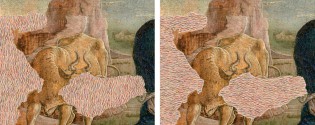
12. Virtual restoration
I use a digital simulation to help restorers restore paintings. To this end, I photograph a sample the restorer has made – exactly to scale – and integrate it electronically into the work of art. This allows me to see whether the chosen technique will harmonise with the original piece of art. Even the direction of the paintbrush strokes can be adapted virtually.
To download additional information, please click here:
Trento.pdf
OPD_restauro2002.pdf
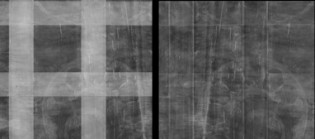
13. Additional methods
The demands on art diagnosis are very varied and new aspects crop up frequently. There is also a lot going on in the area of art restoration, and I adapt quickly and unconventionally to any changes. The result: solutions for professional visualisation, because making something visible reduces the need for lengthy explanations and speeds up the process.
These additional methods are also part of my portfolio:
- X-ray image matching and material strength compensation
- Stitching
I subdivide the work of art into a kind of mosaic. I then adapt the size of the individual images to the desired resolution. Next, I create single exposures that overlap approx. 15-20 cm. These single exposures are then assembled electronically into one picture. - Databases covering a huge rage of materials
- CT-evaluation with Osirix software
Equipment
Highly professional and mobile special technology
delivers the best results
The best CMOS sensor technology with the smallest possible pixel size combined with high-quality German optic design, danish camera technology and highly professional Cultural Heritage software creates the basis for the greatest resolution, optimal color calibration (FADGI, Metamorfoze, ISO Norm) and, consequently, the best possible quality. You choose the level of quality, and I deliver the results.
My custom-made, mobile LED lighting systems from ultraviolet to near infrared with a high luminance efficiency and little heat generation are ideally suited for use at the studio, up scaffolding or at your premises.
A selection of my equipment:
- Phase One XF technology with full frame medium format sensor 150MP latest generation camera with only 3.76 x 3.76 micron pixelsize, 16bit color depth
- Phase One Rainbow MSI system for automated recording of multiband & narrow band image stacks. Automated calibration of focus and size adjustment, flat field for lighting homogenization and lens vignetting correction and white balance as well as exposure and gamma correction
- Lenses designed by Schneider Kreuznach
- Macro equipment with an image ratio of up to 1: 1
- CaptureOne professional Cultural Heritage software for camera control and RAW data processing
- Apple Mac & PC
- Eizo high-end monitor 27” with professional monitor calibration
- Special lighting: wavelengths between 365nm and approx. 1050nm
- Special glass filter
- Special targets for MSI calibration in reflection and luminescence: Spectralon PTFE reference wedge with 8 different reflectance values from 2% to 99% (linear from 360nm to 1100nm), chrome ball for the measurement of highlight and the control of the ambience as well as the analysis of the overexposed areas, light trap for control of absolute black level, ColorChecker for calibrating the visible image, UV innovation target and luminous pigment for UVL calibration, various pigments for IRL calibration.
